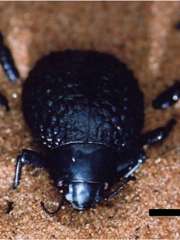Biomimetic dew harvesters

Insects are full of marvels - and this is certainly the case with a beetle from the Tenebrionind family, found in the extreme conditions of the Namib desert.
Now, a team of scientists has demonstrated that such insects can collect dew on their backs - and not just fog as previously thought. This is made possible by the wax nanostructure on the surface of the beetle's elytra. These findings by José Guadarrama-Cetina, then working at ESPCI ParisTech, France - on leave from the University of Navarra, in Spain - and colleagues were recently published in European Physical Journal E. They bring us a step closer to harvesting dew to make drinking water from the humidity in the air. This, the team hopes, can be done by improving the water yield of man-made dew condensers that mimick the nanostructure on the beetle's back.
It was not clear from previous studies whether water harvested by such beetles came from dew droplets, in addition to fog. Whereas fog is made of ready-made microdroplets floating in the air, dew appears following the cooling of a substrate below air temperature. This then turns the humidity of air into tiny droplets of water because more energy - as can be measured through infrared emissions - is sent to the atmosphere than received by it. The cooling capability is ideal, they demonstrated, because the insect's back demonstrates near-perfect infrared emissivity.
Guadarrama-Cetina and colleagues also performed an image analysis of dew drops forming on the insect's back on the surface of the elytra, which appears as a series of bumps and valleys. Dew primarily forms in the valleys endowed with a hexagonal microstructure, they found, unlike the smooth surface of the bumps. This explains how drops can slide to the insect's mouth when they reach a critical size.
Journal information: European Physical Journal E
Provided by Springer





















